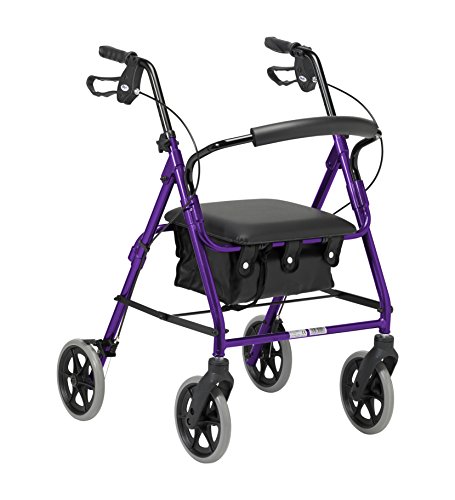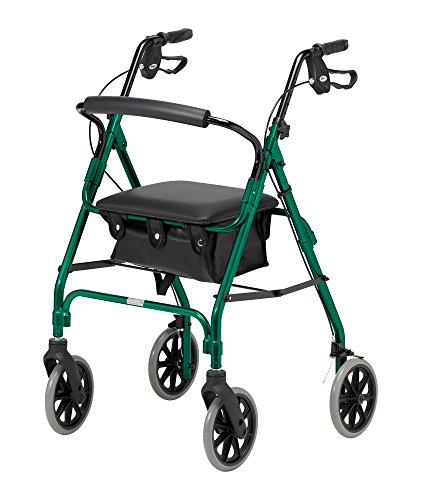9 . What Your Parents Teach You About Rollator Walker Folding
페이지 정보
작성자 Mellissa 작성일24-07-23 08:09 조회8회 댓글0건관련링크
본문
 Taking Care of a Rollator Walker
Taking Care of a Rollator Walker Unlike traditional walkers, lightweight rollators have wheels on their legs. They also have a built-in seating. They are more user-friendly, as the user doesn't need to lift the device.
Unlike traditional walkers, lightweight rollators have wheels on their legs. They also have a built-in seating. They are more user-friendly, as the user doesn't need to lift the device.They can also fold up quickly and easily to fit in tight spaces or into a vehicle for transportation. To do this, they must be equipped with a folding mechanism, and may be equipped with latches or locks.
The Folding mechanism is activated.
Taking care of your rollator walker is a crucial aspect of using this mobility aid. Inspecting it regularly and maintaining it well will prolong its life and ensure your safety during your next outdoor adventure.
The process of inspecting your walker and making sure that it is safe to use includes checking the grips, rubber tips, and wheels (if they have them). The grips should be firm and not moving around. A loose grip could result in injuries to your hands, or even cause a fall. The rubber tips should also be in good shape and not show signs of wear. The wheels should be able to move smoothly without showing any signs of damage or wear. The brakes should be able to stop the walker without trouble.
Also, make sure that the locking mechanism on your walker is in place before you use it. This will stop it from unintentionally unfolding when you walk or carrying it. This feature is important particularly if you intend to use your walker in busy areas or in the outdoors.
Some rollator walkers come with seating areas and storage baskets that are ideal for resting or transporting personal items. They also have hand-operated brakes which can be activated to regulate the speed and direction of the walker's motion. These features make them ideal for those who require more support than a two-wheeler but who are not stable enough to utilize the four-wheel rollator wheelchair combo uk.
Some people find it beneficial to adjust the handle's height to their ideal level. This is particularly beneficial for people who have limited upper body strength or who have trouble bending over or picking up objects. The height of the handle can be adjusted in increments to make sure that the hands of the user are in a comfortable position to push and brake. Handle grips are also adjusted to fit the shape of the hand and size. This eases the stress on hands and wrists.
The Folding Mechanism that is loosening
Walkers are a secure and effective method of increasing mobility for older adults. There are a variety of models that suit different budgets and needs. Foldable walkers are among the most flexible alternatives. They can be easily transported by car or truck to use while traveling. These walkers are suitable for a wide range of situations, including when visiting relatives and friends.
However, some users might be confused about how to fold a walker to make it easier for storage and transportation. While the procedure will differ between models but following a few basic steps can make this task simpler. Before starting, it is important to locate and loosen the mechanism that folds the walker. It is usually located in the middle of the device. It could be secured with a latch or lock. Once the folding mechanism has been loosed it is crucial to make sure that the device is completely closed prior to transporting it.
Once the folding mechanism is loosened, the walker can be folded by pulling the two hand grips away from one another. A lot of modern rollators have adjustable handles that allow users to change the angle of their hand position and get a more comfortable grip. This can be helpful to those with weak hands or weakness, as it will allow them to maintain their independence while using the walker.
Modern walker models include brakes that can be used to stop or slow down the device. Certain models have brakes that are locked and can be used to stop the walker from rolling while the user sits on it. This is useful for people who have to rest for extended periods of time.
Finally, it's recommended to regularly check the wheel and hinge mechanisms of a walker to look for signs of wear or damage. It is also recommended to oil all moving parts to keep them running smoothly. Doing this will reduce the risk of accidental injury or misalignment which can lead to instability and difficulties maneuvering. Additionally, it's a good idea to store the walker in a clean, dry environment when it is not in use. This will extend the life of the product and ensure it is in good condition for use in a variety of environments.
Folding the Walker
Rollator walkers can be an excellent method of increasing mobility and independence for seniors. However, knowing how to fold it correctly is essential to ensure it's secure and safe during travel. Whether you're heading to the grocery store or attending a family gathering learning how to quickly and efficiently fold a walker can ensure that it will arrive in good condition.
Before folding the walker, it's crucial to assess the situation and determine the level of stability you need. Most walkers have adjustable handle heights that allow you to adjust them to your desired height. This is particularly important in the case of arthritis or any other health issue that affects your grip strength. In addition, the seat's height can be adjusted to meet your needs.
Next, you'll need to find the mechanism for folding of the walker This can be found near the handle, seat or frame. Activating this device can be simple as pressing a button or pulling a lever however, it is recommended to follow the manufacturer's instructions for your specific model. After activating the device, let it go or release any latches that are holding it in place. Then, you can begin folding.
When you're ready to fold your walker, sit it on flat surfaces. Then, hold the handles with both hands and place them a little above your hips. Your elbows should be bent slightly, and your shoulders relaxed. Your feet should be in the frame. If they're too close, it can be hard to maneuver the wheels without putting excess pressure on your feet.
After you have positioned your walker in the ideal position and you are in a comfortable position, slowly pull the handgrips up to open the device. Then, you can move forward until you can clearly see the handlebars and seat. If you are unsure of the exact location of the seat then you need to take a look at the orange or red label located at the lower part of the.
After the walker is fully opened, it must be secured with any locks and latches that stop it from slamming open while in transit or storage. If you're planning to store the device in a vehicle, ensure that all doors and trunk are closed before placing it inside. You should also remove any items that are not secure enough to be placed in the vehicle prior to transporting it to prevent unintentional damage or movement.
Then, put the Walker in the Car
If you're a caregiver and has a loved one who is using a walker, you're aware of how important it is to be in a position to help them get into and out of their car. A good walker should be light, able to adjust its height and have level feet. This will ensure that the walker sits evenly on all four wheels and doesn't end up falling to one side. Also, you should ensure that the walker folds easily. Some models come with an latch that holds the folding mechanism in place which makes it easier to raise up and down. Other models come with an easy ratchet strap as well as hooks.
The addition of a tray or basket on the walker can help seniors to carry their belongings while walking. It is important to keep in mind, however, that many attachments could hinder the folding process. It's best not to attach anything to a walker that isn't essential to walk on.
While walking aids are a wonderful option for seniors but there's a better option that provides more stability and comfort and comfort: the rollator. These advanced mobility aids give the assistance needed to move around, while also allowing users to rest and stop whenever they want.
In addition the seat on a rollator could be used for sitting down, giving seniors the opportunity to stop for a break from walking. This helps them stay more active and prevents the downward health spiral that results from being sedentary.
When looking for a walker, or rollator, pick one that is light and has easy-to-grip handles. Try out a few different sizes to determine which one is the most comfortable for your loved one or for yourself. Some walker and rollator handle grips are made of foam or other soft materials to ease pressure on the hands for those suffering from arthritis.
Consider changing the location in which your loved one has placed the walker or rollator in their car if they're struggling. For example, some seniors find it easier to carry a walker into the backseat of a hatchback, rather than the trunk.
댓글목록
등록된 댓글이 없습니다.




